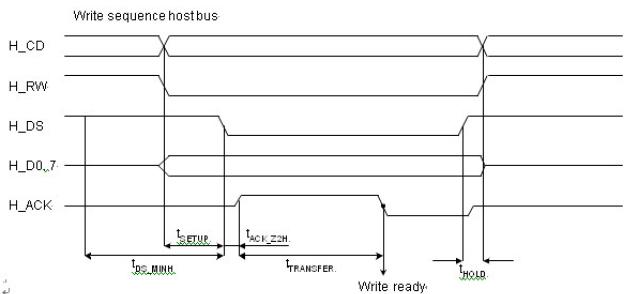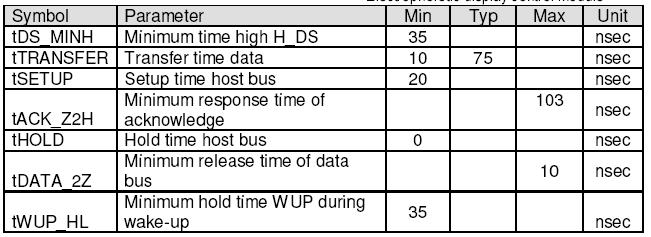how to work with timing?
Hi guys,
I have this display interface connected to my Prop. I wrote the driver that implements all functions and everything works but the most important feature. One of the functions is to work only on part of the display so I do not need to refresh the entire picture.
The problem seems to be a timing issue. If I debug the function with PASD then it works. If I run it at 80Mhz then it doesn't...wierd snce all other functions work!!!!.
Now...attached you can see the time chart and the times for the different operation. I tried to insert delays almost everywhere and covering almost all possible combinations...no way...now I need a scientific way to fix this problem [noparse]:)[/noparse]
The ACK signal goes up and down then I thought to intercept the falling edge by using waitpeq and waitpne...but I failed again.
Can you guys help to understand how to work with "synch" between prop and my display?
Thanks!!!
I have this display interface connected to my Prop. I wrote the driver that implements all functions and everything works but the most important feature. One of the functions is to work only on part of the display so I do not need to refresh the entire picture.
The problem seems to be a timing issue. If I debug the function with PASD then it works. If I run it at 80Mhz then it doesn't...wierd snce all other functions work!!!!.
Now...attached you can see the time chart and the times for the different operation. I tried to insert delays almost everywhere and covering almost all possible combinations...no way...now I need a scientific way to fix this problem [noparse]:)[/noparse]
The ACK signal goes up and down then I thought to intercept the falling edge by using waitpeq and waitpne...but I failed again.
Can you guys help to understand how to work with "synch" between prop and my display?
Thanks!!!




Comments
▔▔▔▔▔▔▔▔▔▔▔▔▔▔▔▔▔▔▔▔▔▔▔▔
My question is about what should I do to "wait" the right moment to set H_DS high.
This is what I do.
or OUTA, m_DataByte ' set data bits
andn OUTA, m_RW ' set R/W direction
andn OUTA, m_CD ' set Command/Data selector
mov timer, cnt ' I wait a set up time
add timer, #T_Setup
waitcnt timer, #T_setup
andn OUTA,m_DS ' set m_DS (=H_DS) low
' HOW DO I WAIT FOR H_ACK?
or OUTA,m_DS ' set m_DS (=H_DS) high
I see that H_ACK is undefined right after DS goes low, then it goes HIGH then LOW then undefined.
It is not clear to me how I should wait before setting H_DS low.
Thanks
The code should look like
or OUTA, m_DataByte ' set data bits
andn OUTA, m_RW ' set R/W direction
andn OUTA, m_CD ' set Command/Data selector
mov timer, cnt ' I wait a set up time
add timer, #T_Setup
waitcnt timer, #T_setup
andn OUTA,m_DS ' set m_DS (=H_DS) low
waitpeq 1,m_ACK ' detect falling edge of m_ACK
waitpeq 0,m_ACK
or OUTA,m_DS ' set m_DS (=H_DS) high
but cog hangs forever....
Is the undefined part of ACK involved here?
Assuming that m_ACK is a bitstring for the ACK pin, the first waitpeq will probably not work because the "1"
probably isn't in the right bit position. I like to use zero all the time for the destination field when it can work,
so a waitpne 0,m_ACK will continue when ACK is high, then the waitpeq 0,m_ACK will continue when the ACK
becomes low.
In this case
m_ACK long |< H_ACK
where H_ACK is defined as
H_ACK = 15 in CON section
I'll try your "method"....
thanks
The first waitpeq is unlikely to work, you may well AND with the right mask (condition is D == (INA & S)) but you compare against register 1. Which - unless you have an absolute branch at location 0, and some constants after that - I doubt is what you intended to do. Note that immediate mode only works with the source operand. So given that register 1 most likely holds some active code (rather than data) the cog will sit there forever.
I'd suggest something like this (assuming m_ACK being a register with the required bit pattern):
HTH
Post Edited (kuroneko) : 5/16/2008 3:14:38 AM GMT
waitpeq flag, flag ' wait for a high
waitpne flag, flag ' wait for a low.
▔▔▔▔▔▔▔▔▔▔▔▔▔▔▔▔▔▔▔▔▔▔▔▔
One last question...how would you implement a timeout on those wait?
1) If you have an unused I/O pin and a free counter, you can set up the counter to output a high for a period of time, then output a low.· The WAITPEQ or WAITPNE would include that I/O pin in its pattern and that transition would terminate the wait.· The I/O pin doesn't have to be connected to anything since the implicit INA refers to the I/O pin state (which has to be output for the counter to change it).
2) You could forget the WAITxxx and just have a loop in assembly language that tests for an I/O pin pattern, then tests for a timeout, then loops back to try again.· This takes more power since the cog is running, but it's not a lot of power.